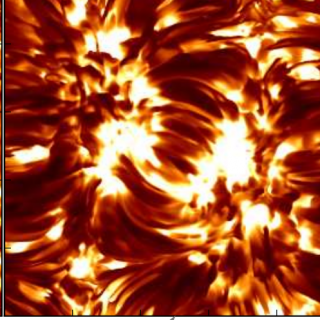Bibcode
Díaz Baso, C. J.; Martínez González, M. J.; Asensio Ramos, A.
Referencia bibliográfica
Astronomy and Astrophysics, Volume 625, id.A128, 18 pp.
Fecha de publicación:
5
2019
Revista
Número de citas
26
Número de citas referidas
23
Descripción
Aims: The determination of the magnetic filed vector in solar
filaments is made possible by interpreting the Hanle and Zeeman effects
in suitable chromospheric spectral lines like those of the He I
multiplet at 10 830 Å. We study the vector magnetic field of an
active region filament (NOAA 12087). Methods: Spectropolarimetric
data of this active region was acquired with the GRIS instrument at the
GREGOR telescope and studied simultaneously in the chromosphere with the
He I 10 830 Å multiplet and in the photosphere Si I 10 827 Å
line. As has been done in previous studies, only a single-component
model was used to infer the magnetic properties of the filament. The
results are put into a solar context with the help of the Solar Dynamic
Observatory images. Results: Some results clearly point out that
a more complex inversion had to be performed. First, the Stokes V map of
He I does not show a clear signature of the presence of the filament.
Second, the local azimuth map follows the same pattern as Stokes V; it
appears that polarity of Stokes V is conditioning the inference to very
different magnetic fields even with similar linear polarization signals.
This indication suggests that the Stokes V could be dominated from below
by the magnetic field coming from the active region, and not from the
filament itself. This evidence, and others, will be analyzed in depth
and a more complex inversion will be attempted in the second part of
this series.
Proyectos relacionados

Magnestismo Solar y Estelar
Los campos magnéticos son uno de los ingredientes fundamentales en la formación de estrellas y su evolución. En el nacimiento de una estrella, los campos magnéticos llegan a frenar su rotación durante el colapso de la nube molecular, y en el fin de la vida de una estrella, el magnetismo puede ser clave en la forma en la que se pierden las capas
Tobías
Felipe García

Magnetismo, Polarización y Transferencia Radiativa en Astrofísica
Los campos magnéticos están presentes en todos los plasmas astrofísicos y controlan la mayor parte de la variabilidad que se observa en el Universo a escalas temporales intermedias. Se encuentran en estrellas, a lo largo de todo el diagrama de Hertzsprung-Russell, en galaxias, e incluso quizás en el medio intergaláctico. La polarización de la luz
Ernest
Alsina Ballester